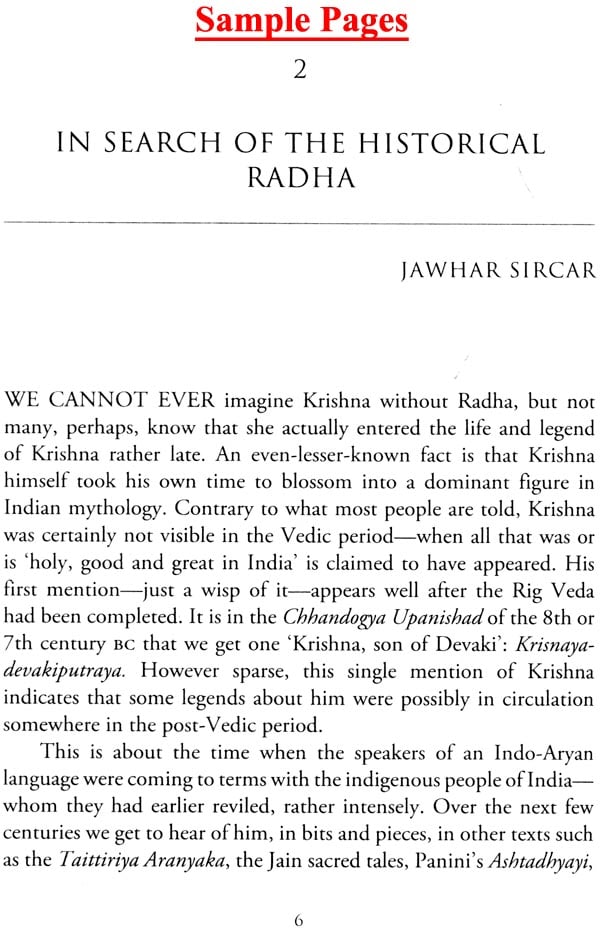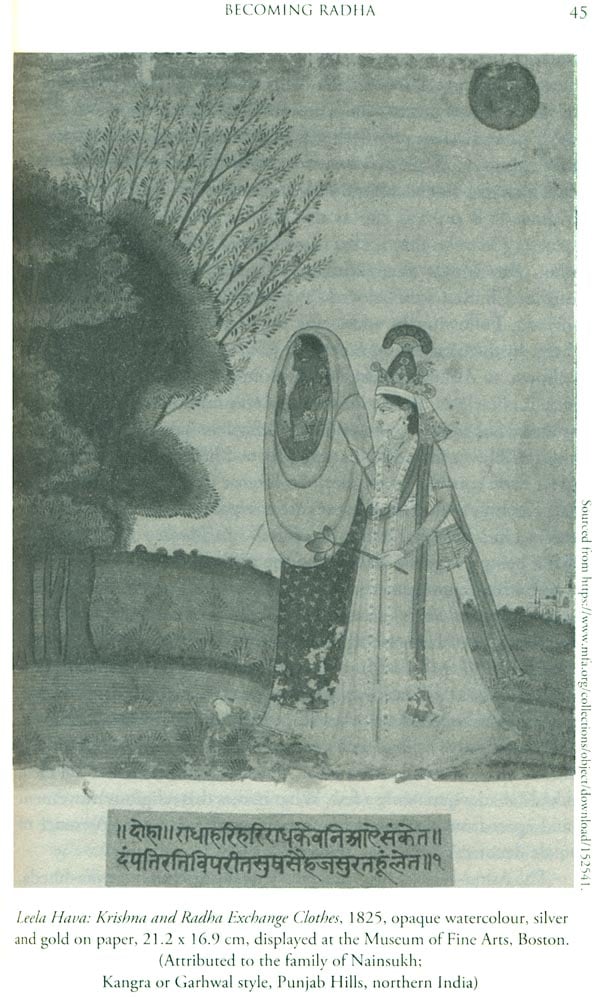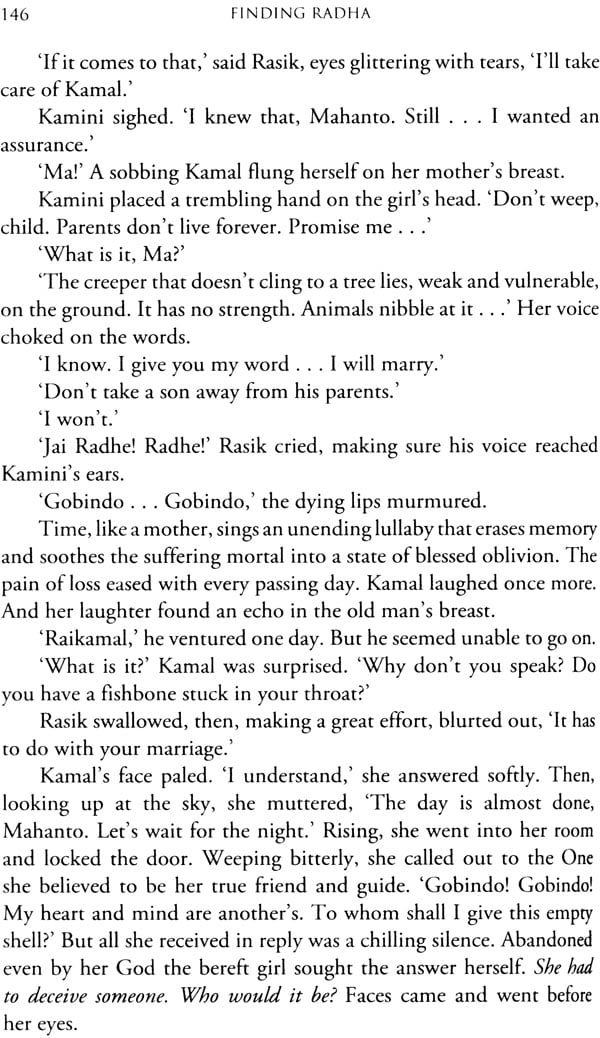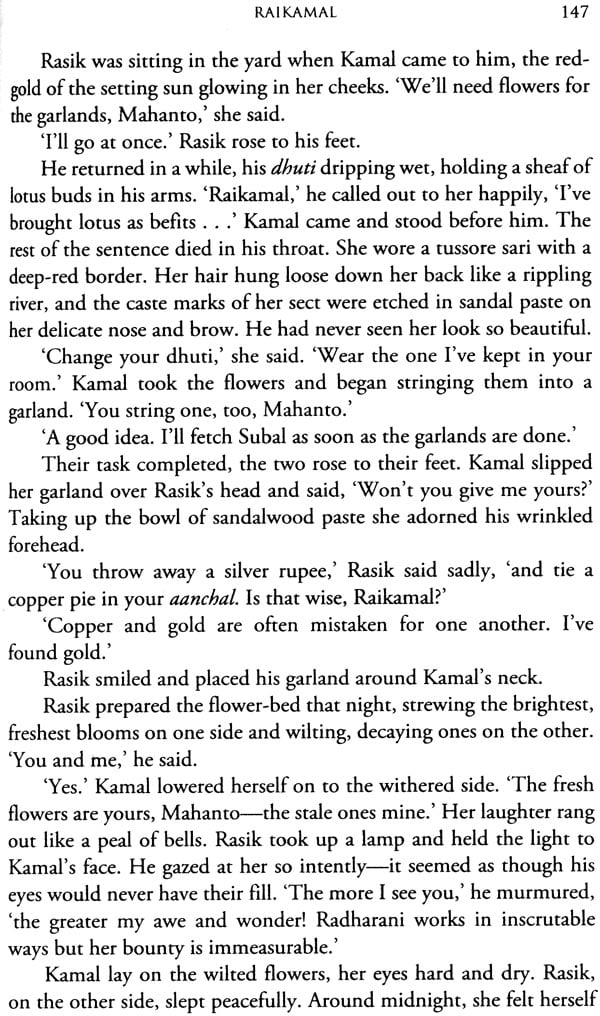
Finding Radha - The Quest for Love
Book Specification
| Item Code: | NAO581 |
| Author: | Malashri Lal & Namita Gokhale |
| Publisher: | Penguin Books India Pvt. Ltd. |
| Language: | English |
| Edition: | 2018 |
| ISBN: | 9780143441458 |
| Pages: | 295 (2 B/W Illustration) |
| Cover: | Paperback |
| Other Details | 8.5 inch x 5.5 inch |
| Weight | 270 gm |
Book Description
Who was Radha, and why has she captured the imagination of so many writers across centuries? 0 other goddess combines the elements of bhakti and shringara quite as exquisitely as the divine milkmaid. She spans a vivid rainbow of imagery-from the playfulness of the Raas Leela to the soulfulness of her undying love, from the mystic allure of her depictions in poetry, art and sculpture to her enduring legacy in Vrindavana. In a way that sets her apart from other female consorts, Radha is idealized and dreamed of in a way that is almost more elemental than mythical.
Namita Gokhale and Malashri Lal, who brought us In Search of sita: Revisiting Mythology, now present an anthology on the mysterious Radha, the epitome of love, who defies all conventional codes yet transcends social prohibitions through the power of the spiritual and the sensual, the sacred and the erotic. Finding Radha is the first of its kind: a collection of poetry, prose and translation that enters the historical as well as the artistic dimensions of the eternal romance of Radha and Krishna.
MALASHRI LAL, professor in the English department of the University of Delhi, recently retired from her academic and administrative positions. Currently she is member of the English Advisory Board at the Sahitya Akademi. Her specialization lies in literature, women and gender studies, and she has to her credit around fifteen books including The Low of the Threshod: Women Writers in Indian English, Speaking for Myself; An Anthology of Asian Women’s Writing, In Search of Sita: Revisiting Mythology and Tagore and the Feminine: A Journey in Translations. Lal has been a senior consultant to the Ministry of Culture, a University Grants Commission IUGC) nominee on committees and a member of international book-award juries.
NAMITA GOKHALE is a writer, publisher and festival director. She is the author of sixteen works of fiction and non-fiction. Her acclaimed debut novel, Paro: Dreams Dreams Passion, published in 1984, has remained a cult classic and has been issued in a double edition with its sequel, Priya. Gokhale has worked extensively across genres on Indian mythology, including her retelling of the Indian epic in the Puffin Mahabharata, and her novel for young readers, Lost in Time: Ghatotkacha and the Game of Illusion. The edited anthologies Himalaya: Adventures, Meditations Life and the Himalayan Arc: Journeys East of South-east provide valuable resource material on the culture and politics of the region. Gokhale is also founder and co-director of the Jaipur Literature Festival and of Mountain Echoes, the Bhutan literature festival. She is director of Yatra Books, a publishing house specializing in translations.
HOW DID RADHA come to me? Perhaps it was when I was roaming the narrow lanes of Vrindavana, in search of these elusive mysteries. Amidst the groves of ancient basil bushes stood a room with a bed in it, designed in the style of a government guest house in a minor mofussil town. It had iron shutters through which I could glimpse a postered bed. It was here that they met, those two, in a timeless nocturne, through the yugas, across the ages.
The attendant priest handed me a bundle of prasad. The packet he gave me contained some sweet crumbling pedas, fragrant tulsi leaves, a folding mirror, some bindis, glass bangles, a bottle of cheap fluorescent-pink nail polish. The last three items constituted a traditional 'suhag ka pitara', a gift symbolizing the auspicious feminine. It as a moment of illumination. The importance of it, the crucial nuance, came to me in a flash. The mirror was a gateway to the recognition of selfhood. The bangles were a form of armour. I don't ever wear bindis, but they represent the awakening of the third-the inner-eye. It was the nail polish that moved me the most, it spoke to me of hopes and yearnings and betrayals, the entire tradition of shringara rasa', the evocation of the mood of romantic and erotic love from the Natyashastra that is such a deep undercurrent of Indian culture.
We began this quest for Radha some years ago, after Dr Malashri La! and I had completed our edited anthology In Search of Sita. Radha is an all-too-human goddess, a sublime yet sensual emblem of mortal and divine love. She is subversive in that she possesses an autonomy rarely available to feminine deities. She lives by her own rules, and not those of the world. She is the essential Rasika, the aesthete of passion, and her wild heart belongs only to herself.
Like Sita, Radha is also a manifestation of Lakshmi. Radha is the essential Shakti of Krishna, just as Sita is the consort of Rama. Yet their lives span very different arcs. Sita is the sterling emblem of familial duty, who unflinchingly complies with the dikrats of her patriarchal and hierarchical world. She is relentlessly questioned and tested, and subjected not once but twice to the 'Agni pariksha', the test by fire, driving her to relinquish the harsh obligations of royal conduct and return deep into the womb of the earth mother.
Radha, the bucolic milkmaid, follows the dictates of her heart, of her instincts, of her passion, to seek union with her innermost self. She is her own mistress even in the act of surrender to her beloved. And it is this aspect of her that is worshipped, if not emulated, in shrines, temples and festivals all across India even today. The enigma of Radha and the example of Sita coexist and are both contained in the apparent paradoxes and composite unity of the Hindu religion. The lack of any textual references to Radha in the Mahabharata, and the only indirect allusions in the Srimad Bhagavatam, establish that the rebellious figure of Radha was born of the a historical collective consciousness of religion and culture. She was born of the need to establish a direct emotional and mystical relationship, a sensual, tactile, immersive connect, with the sacred. Radha's divine lover, Krishna, was later married to Rukmini, and to Satyabhama, and later in some texts, to Jambavanti. Yet he remained hers, and she his, in the hearts and minds of the devout.
India's great epics and scriptures were born of orality; they have been retold, reinterpreted and remained through millennia. Even as the plasticity and porous narrative of oral traditions yielded to the stricter boundaries of textual veracity, the format of palm- leaf manuscripts was amenable to interpolations and imaginative embellishment. These acts of appropriation and interpretation and translation through successive generations, through the centuries, led to the continuous rediscovery of the core stories, and kept them relevant and contemporary across the passage of time. They were birthed anew and belonged to each poet, scribe or bard, each dancer and sculptor, who bestowed them with form and creative reality. The figure of Radha was first mentioned in the medieval period, in the exquisite Gita Govinda of the poet Jayadeva of modern-day Odisha, and in the maha-mantra of Radha and Krishna extolled by Nimbakacharya in the 11th and 12th centuries. This anthology carries many perspectives on how the visualization and iconography of 'Radharani' evolved, through the Chaitanya school of Vaishnavism, and the philosophical and poetic interpretations of the Bhakti movement. These traditions were continued in the late 15th century in the magnificent poetry of Chandidas of Bengal and Vidyapati of Mithila, and later in the verses of the blind seer Surdas.
The essence of the relationship between Radha and Krishna resides in its spontaneous acquiescence to the moment of joyous union, and its disregard for imposed social boundaries in love, sacred or profane. This sense of abandonment, of surrender, would have been, and still is, exhilarating and liberating in a prescriptive and regimented society.
The sensory and the physical are as profound as all the navel- gazing in the cosmos. Our duplicitous and illusory world belongs to the realm of what is described as maya, and we are all entangled in the 'maya jaal , in the phantasmagorical web of the virtual and the unreal. The amorous frolics of the divine lovers are described not as Maya jaal as Leela, as the eternal play of consciousness, the dream of the awakened.
As with depictions of Shiva and Parvati, there is a remarkable gender fluidity in images of Radha and Krishna. She is him as he is she; together they are 'ardha Radha Venudhara' the two halves of one self, joined in the ultimate rasa of spiritual rapture. In the complicated inversions that come so easily to Hindu mysticism, Shri Radha is Krishna himself represented in female form. Her relationship with the other milkmaids, the gopis, is one of sisterhood. The sakhi, or female and confidante, is an important motif in the tales of Radha and Krishna, Celebrating sorority and the dance of Love.
| Acknowledgements | xi |
| Introduction: The Dream of the Awakened | xiii |
| Introduction: Radha through Many Eyes | xix |
| 1. A Milkmaid Called Radha | 1 |
| 2. In Search of the Historical Radha | 6 |
| 3. Radha and the Completion of Krishna | 12 |
| 4. Gita Govinda: Illustrated Manuscripts from Rajasthan | 17 |
| 5. Integrating the Natural, the Divine and the Erotic in the Gita Govinda and Shir Ha-Shirim | 29 |
| 6. Becoming Radha | 36 |
| 7. Radha: Beloved of the Blue God | 49 |
| 8. Enjoing God: The Divine Paramour | 55 |
| 9. Radha: The Play and Perfection of Rasa | 80 |
| 10. Understanding Radha's Symbolic Love | 86 |
| 11. The Heart-throb of Chaitanya | 92 |
| 12. Radhe Radhe | 100 |
| 13. The Blue-necked God | 104 |
| 14. Krishna: The Playful Divine | 108 |
| 15. Radha in Nazrul Geeti | 115 |
| 16. Lovelorn Radha, Forlorn God | 121 |
| 17: Radha: The Unfading Mystic Blossom in Our Midst | 131 |
| 18. Raikamal | 138 |
| 19. A Flute Called Radha | 154 |
| 20. Radha in Bollywood Cinema | 167 |
| 21. Sita and Radha: From Human to Divine | 176 |
| 22. Songs of Radha | 182 |
| I. Vidya | 182 |
| II. Andal | 183 |
| III. In Praise of Krishna: Translation of Gita Govinda of Jayadeva | 184 |
| IV. Gita Govinda: Love Songs of Radha and Krishna | 193 |
| V. Vidyapati | 195 |
| VI. Narsinh Mehta | 196 |
| VII. Chandidas | 197 |
| VIII. Surdas | 198 |
| IX. Rupa Goswami | 199 |
| X. Bihari | 199 |
| XI. Subrahmanya Bharathiyar | 200 |
| XII. Rabindranath Tagore, Bhanusingher Pdvali | 201 |
| XIII. Kazi Nazrul Islam | 201 |
| 23. Sri Radha | 202 |
| 24. Kanupriya | 214 |
| Notes | 217 |
| Bibliography | 231 |
| Lists of Contributors | 237 |
| Copyright Acknowledgements | 249 |
| Index | 253 |












